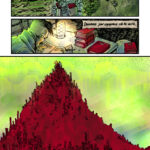The Czech-Polish border splits the ridge of the Giant Mountains. This is the domain of Rübezahl. Originally a weather giant, their appearance evolved along with their mythology. At once Wise Woman, and wizard-like monk, Rübezahl became guardian of the mountains.
—-
In 1561 the German cartographer Martin Helwig created a beautifully detailed map of Silesia (a historical region of Central Europe, mostly now Poland, but also including parts of the Czech Republic and Germany). On the Riesageberge mountain range (now known as The Giant Mountains) Helwig drew a strange figure: a shaggy-legged, stag-like creature, standing on two feet and holding a tall staff in its hands. Beneath it he wrote “Rübezahl”.
“Over all the vast under-world the mountain Gnome Rübezahl was lord; and busy enough the care of his dominions kept him. There were the endless treasure chambers to be gone through, and the hosts of gnomes to be kept to their tasks. Some built strong barriers to hold back the fiery rivers in the earth’s heart, and some had scalding vapours to change dull stones to precious metal, or were hard at work filling every cranny of the rocks with diamonds and rubies; for Rübezahl loved all pretty things. Sometimes the fancy would take him to leave those gloomy regions, and come out upon the green earth for a while, and bask in the sunshine and hear the birds sing. And as gnomes live many hundreds of years he saw strange things.”
This is the opening paragraph from “Rübezahl” – a tale recorded in Andrew Lang’s The Brown Fairy Book (1904). Lang’s is a retelling of an old Silesian story, first recorded in print by Johann Karl August Musäus in his Volksmärchen der Deutschen (“Folktales of the Germans“) published in 1791. In the story we learn that the being known as Rübezahl kidnaps a beautiful princess, trying to keep her entertained by using his magic to transform turnips into likenesses of the friends and family she has left behind. As the enchanted vegetables wither their human forms also grow soft and weak however, so Rübezahl is forced to quest for more and more turnips. Eventually the princess makes good her escape while Rübezahl is busy counting all the turnips in a field, and this is where his nickname comes from: rübe (“turnips”) zählen (“count”) – Turnip Counter. As such, the name is actually an insult, and a reminder of a time when the creature was outsmarted. More respectful terms of address include Lord of the Mountain, Treasure Keeper, Lord John, and Prince of the Gnomes.
It is believed that the creature or deity thought to inhabit the Giant Mountains began its life as a Weather Giant, like the Norse jötnar (also known as Trolls). The Norse Pagan God Odin was said to be a descendant of the jötnar, and soon the giant Rübezahl seems to have taken on the manner and appearance of his cousin; becoming a bearded, monk-like figure dressed all in grey (and the inspiration for Tolkien’s Gandalf the Grey). Able to change shape at will, Rübezahl would sometimes take the form of animals and birds. Sometimes he becomes a she and takes on the mantle of Wise Woman, or the guise of a helpless old woman in distress in order to test the heart of the human they have encountered. Strangely though, no extant tales of Rübezahl seem to even hint at the bizarre, demonic stag-like form as depicted by Martin Helwig in the 16th century.















Recent Comments